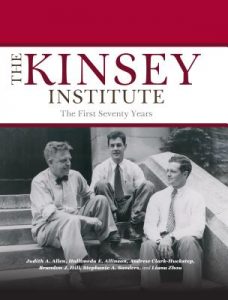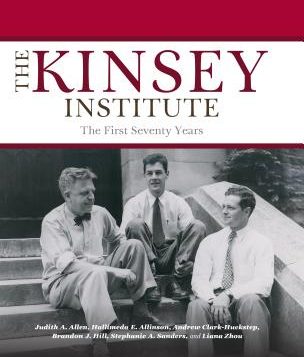 The Kinsey Institute: The First Seventy Years
The Kinsey Institute: The First Seventy Years
by Judith A. Allen, Hallimeda E. Allinson, Andrew Clark-Huckstep, Brandon J. Hill, Stephanie A. Sanders, and Liana Zhou
Indiana Univ. Press. 272 pages, $35.
IN JULY 2010, while attending a conference on East Asian studies at Indiana University, I dropped in at the Kinsey Institute, a research unit within the University. I’d made an appointment to see their collection of Chinese erotic art. An archival folio of drawings and prints was brought out for me to examine. I spent a delightful afternoon with the curator studying each beautiful, and surprisingly graphic, image. Nearby, some graduate students were cataloguing a box of dildos, mostly from the early 20th century, part of the Kinsey Institute’s extensive archive of sex-related objects. These interns went about their work with a remarkable sense of sobriety and professionalism. At the end of my visit, I met Liana Zhou, the Director of the Kinsey Institute Library, who proudly showed me a rare 1610 copy of a Ming dynasty erotic novel.
My visit to the Kinsey Library was such an enjoyable experience that when I learned that Indiana University Press was bringing out a history of the Institute, I eagerly sought out the book. I was looking forward to reliving some of the pleasure I’d had during my visit to the Library that afternoon. Alas, The Kinsey Institute: The First Seventy Years is not a particularly fun book to read. Written by a team of historians, professors, and (full disclosure here) Ms. Zhou, the librarian I met back in 2010, the collective approach robs the prose, and the story, of a lot of narrative pizzazz. To be fair, there is plenty of historical information and analysis of the politics of sex research to satisfy scholarly curiosity, but most casual readers will probably find the book, as I did, a dry if workmanlike account of the trials and tribulations of this venerable institution.[/groups_member]
A certain amount of well-deserved self-congratulations pervades this anniversary book, which traverses the history of the Institute’s brave struggle for legitimacy amid an often hostile environment. It’s a story that begins, of course, with Alfred Kinsey, the Institute’s founder. Kinsey was a Harvard-educated entomologist who in the late 1930s turned his scientific attention, and his scorn, on the sweeping, unverified claims about human sexual norms that were passing for science. He sought an approach that would be “unbiased by diagnosis, condemnation, or pathology.

Kinsey conducted his research in the same way as he had previously studied insects: without applying normative prescriptions to his subjects. “Instead of polarizing behaviors into normal/pathological, moral/ immoral, heterosexual/homosexual, and other dualisms,” the authors write, “he plotted human sexual options and behaviors … along a natural spectrum or continuum. His hypothesis of hugely varied human sexual behavior stood to dispel many sex-polarized generalizations.”
Prior to Kinsey, non-heterosexual erotic behavior had fallen “outside the gaze” of most sex research. Kinsey refused to privilege heterosexual coitus over other forms of sexual response. He deplored the medical establishment’s self-proclaimed authority, which condemned sexual subcultures. Behaviors traditionally judged “offensive,” he argued, deserved legitimate scientific investigation. “[T]here is no right, no wrong. … Nothing but the observed truth.” Kinsey showed enormous compassion for ordinary people, the authors say, “particularly those often labeled deviant, sick, or criminal.”
In 1948, the year after he founded his Institute, Kinsey dropped the first of what the authors call his “K-bombs”: Sexual Behavior in the Human Male. Drawing on thousands of interviews (what Kinsey called “sex histories”), the book described male sexual behavior and found a range of sexual behavior that was quite divergent from established beliefs. The book sold in the hundreds of thousands of copies, becoming one of the most popular scientific books of its time.
Five years later, Kinsey published the companion volume, Sexual Behavior in the Human Female. This was an even more controversial book. The main arguments and analytical paradigms that undergirded the male volume did not apply here. Women, he wrote, preferred “a considerable amount of generalized emotional stimulation before there is any specific sexual contact. … Heterosexual relationships could become more satisfactory if they more often utilized the sort of knowledge which most homosexual females have of female sexual anatomy and female psychology.” Among his findings was that women exhibited an even greater spectrum of erotic variation than did men.
Kinsey’s movement away from his earlier conviction that the two-minute coitus was “natural” for both sexes represented an enormous leap forward in his thinking. If sexual life was unsatisfying for women, it was, he now said, for “reasons that were not inherent but rather cultural and contingent.”
During Kinsey’s final years, hostility toward his sex research—both from the psychoanalytic lobby and the conservative, moralistic lay community—persisted. He “never recovered” from such attacks. Funding was pulled from his projects. “Thereafter,” the authors say, “he was an angry, disturbed, obsessed man who was preoccupied with vindication and a refutation of unfounded charges.”
The remainder of the book is an account of the post-Kinsey years, when his Institute faced serious challenges in funding, leadership, management, and access to materials. Into the 1970s, the prevailing scientific and clinical perspective on homosexuals was that they were deviant, abnormal, and pathological. Into this fray stepped the Institute, which undertook several “deviance studies.” These studies, while departing from Kinsey’s original vision—which had questioned the validity of the very category “homosexual”—did shift the language used to describe homosexuality away from “sexual deviance” and toward terms like “sexual preference” and “sexual orientation.”
The hiv/aids crisis created further opportunities and challenges for the Institute, which had become “the international flagship of sex research,” especially in areas related to public health. During this period, the Institute sponsored several conferences and symposia. “Not since the Kinsey Reports in 1948 and 1953,” the authors say, “had the Institute been so much in the public eye.” The Institute also launched an internationally syndicated newspaper column that provided answers to readers’ questions based on the most up-to-date information, “not personal advice or opinion.” The column reached thirteen million people a week. “Am I normal?” was the most common question they received.
During the past two decades, the Institute has come under increasing political pressure. Decreased funding—a major consequence of the polarization brought on by the religious Right and the culture wars—left the Institute struggling to survive. “The level of fear and intimidation is higher now than I can ever remember,” one thirty-year veteran sex researcher told The New York Times. Amid this “tumultuous cultural backdrop,” the Institute bravely adopted a “maintain and grow” priority. Nevertheless, “the battle lines remain drawn,” conclude the authors.
Its second director, Paul H. Gebhard, once described the Kinsey Institute as “healthy, though not flamboyant.” The same might be said of this anniversary history. It covers all the bases, providing a good overview, copious factual information, abundant bibliographies, and lots of yearbook-like photos of the staff and conference attendees. But few would call this a sexy or even a particularly engaging book. Perhaps the team of writers deliberately toned down the fun in order to fly under the radar of their political and ideological opponents. Such are the times in which we live: sex research—and histories of sex research—needs to be a sober business.
Philip Gambone is a frequent contributor to these pages, including a piece on the Shanghai Museum of Sex in the May-June 2003 issue.







